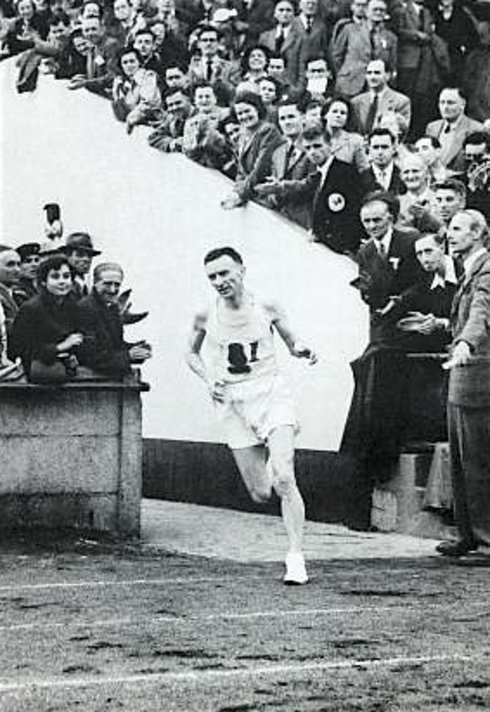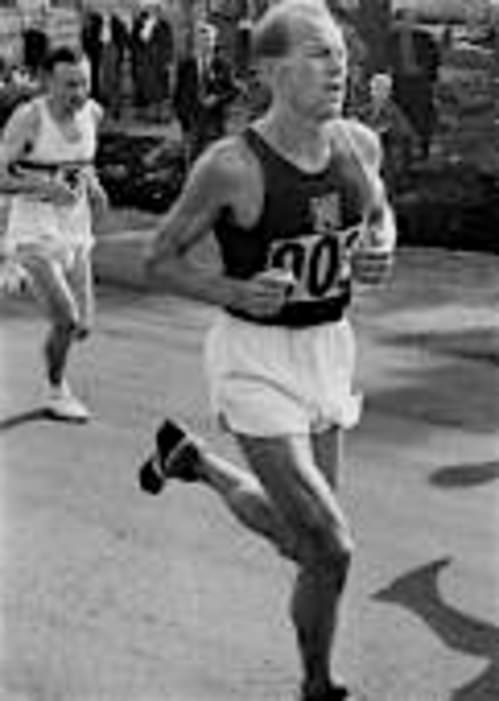JIM PETERS: PROFILE
1918-1999
Jim Peters was one of the greatest marathon runners. His domination in marathon running in the early 1950s is often overlooked because his dramatic collapse near the end of the 1954 Empire Games marathon in Vancouver is so well documented. From his first marathon in 1951, Peters was breaking records. In this marathon, his 2:29: 24 clocking made him the first British runner under 2:30. In the next three years he gradually improved his times. With his Poly Marathon win in 1954, he ran a World Best for the fourth time with 2:17:39.4, his career best. During this progression from 2:29 to 2:17 he was he first man under 2:25 and the first under 2:20. The previous World Best was 2:25:39 by Korean Yun Bok Suh (disputed for being on a short course); Peters improved that by 8:00 over his career. No one before or since has lowered the World Best marathon time by so much.
Beginnings
 |
| Winning yet another Chiswick Marathon. |
Peters came from a relatively humble background. He was 27 when World War 2 ended. The following year he was English 6-Mile champion; the year after that he was the 10-Mile champion. In 1948, after being lapped by Zatopek in the Olympic 10,000, Peters wanted to quit the sport. However, Coach Jimmy Johnston persuaded him to continue running and aim for the Marathon. For three years, Peters trained hard and ran low-key races, all the while working full-time in an optician’s practice in south London. Then in his first marathon, the Poly Marathon of 1951, he burst into prominence. After a great battle with the veteran Jack Holden, who had been winning major races since the early thirties, Peters finished in a British record of 2:29:24. At one point he had been 200 yards behind Holden.
Helsinki Olympics
In the next Olympic year, Peters won the Poly Marathon again in the staggering time of 2:20:43. This time was almost five minutes faster than the world’s best. Of course, he then became the Olympic favorite. No one, at this stage, imagined that Zatopek would be competing in the Olympic Marathon. But the Czech did compete and he did win. Peters tried to run away from him from the start. He was running at 2:09:30 pace at 5K and had a 41-second lead. When he eased off the pace (2:11:30 speed at 10K and 2:11:45 pace at 15K), Zatopek and Jansson closed the gap and caught him at exactly 15K.
It was here that the classic verbal exchange took place. Zatopek asked if the pace was “good enough” and Peters replied “Pace too slow.” Clearly, Peters was hurting as he had been caught; and just as clearly Zatopek was feigning innocence about the pacing. But I doubt whether this had much effect on Peters. He hung on to Zatopek and Jansson for 3K and was only 10m back at the halfway turnaround. But then he fell back, eventually dropping out at 37K with leg cramp—something he said he’d never experienced before. It was a crushing defeat for the race favorite. As Tim Noakes has written, Peters’ disappointing performance can be attributed to two causes: the short six-week recovery period from his 2:20 run and the appalling flight over in a cold and draughty airplane. (Noakes, Lore of Running, p.279) As well, dehydration could have been a factor.
Steady Improvement
 |
| Zatopek passes a weary-looking Peters in the1952 Olympic Marathon. |
The next year (1953) Peters was running just as well, having continued to gradually built up his training workload. In the Poly Marathon he ran even faster with a World Best of 2:18:35 in June. At Enschede he ran 2:19.22 on September 12.
Peters looked in even better form in 1954, leading up to the Empire Games. He ran 2nd in the Boston Marathon after a horrendous transatlantic journey. He won the prestigious Morpeth to Newcastle road race for the third time with a course record. And then he ran yet another World Best for the marathon in the Poly with 2:17:39 on June 26. An Empire Games gold medal in Vancouver looked a certainty.
Vancouver
His Empire Games began well with a bronze in the Six Miles on the track. He led for most of the race, until Sando and Driver roared past him just before the bell. He planned for the Marathon race meticulously with his coach. As the weather was expected to be hot, Peters tried to find a sun hat that he could run with, but he gave up on the idea. The race started at noon, when the temperature was already 25. Peters led with team-mate Cox and Joe McGhee. “We were traveling at a much slower pace than the one we did at home,” he wrote later (In the Long Run, p.197). After nine miles, Cox and Peters had dropped McGhee. And soon Peters was surprised to find he was on his own. Sponges were allowed only at feed stations, but the first two Peters took were dry. Furthermore, no one could tell him what his lead was. And the heat was “overwhelming.” When only half a mile from the stadium, Peters still thought Cox was close behind, so he kept pushing. But Cox had got sunstroke and had run into a telegraph pole. “I actually had a lead of nearly three-and-a-half miles,” Peters wrote. “If I had known that, I could have stopped at the last feeding station, had a good sponge down and trotted in slowly.” (ILR, p.199)
Peters continued: “I set off too fast in the heat, but that was always my way: to destroy the field ... If someone had told me I was so far ahead, I dare say I’d have eased off a bit ... When I woke up in hospital I thought I’d won. When I asked a nurse, she’d said, “You did great, Jim, just great”, so at least I went back to sleep a winner, didn’t I?” (Observer, Jan. 7, 2007)Much has been written on the horrific ending of the Empire Games 1954 Marathon. It is sometimes forgotten that Peters entered the stadium 17 minutes ahead of the field. There is film on the Internet for those who wish to see his agony as he staggered and fell many times. Reports vary on how far he was from the finish when he was taken from the track—from “only yards from victory” to 140m and 200m. According to eye-witness reporter Frank Keating, Peters took eleven minutes to cover 200 yards in the stadium. Peters was suffering from severe dehydration and heat-stroke from the 28-degree sunny conditions. Eventually the team’s masseur Mickey Mays stepped in, called for a stretcher and probably saved Peters’ life. “I was lucky not to have died that day,” Peters told Frank Keating later, adding that since that day he had often suffered from giddiness and what he called “my Vancouver headache.” (Observer, Jan. 7, 2007)
There are four interesting sideline stories to this race. 1. Peters had measured the course beforehand and found it 3/4 mile long. The officials wouldn’t listen to him. He had thus probably finished the marathon distance long before he collapsed. 2. The stadium was jam-packed when he arrived for his last lap. The crowd had just witnessed the epic Bannister-Landy Mile race, which had taken place while the marathoners were out on the roads. 3. Peters pushed himself harder than was necessary to win because he thought Cox was close behind. Some officials, who could have informed him of his great lead, had abandoned their positions in order to watch the Bannister –Landy race. 4. Over the years there have been several published medical studies on Peters’ collapse.
| Two years after his retirement, Peters was still giving tohis sport. Here he is at Barnado's in Barkinside presenting a sprint medal to Ruth Houlihan, who remembers it as"one of the proudest moments of my life." |
Soon after this race, Peters announced his retirement. He had originally planned to continue to the 1956 Olympics: “The plan had been for me to do three runs a day up to the Melbourne Olympics in 1956. I’m certain it would have done the trick. I think I could have run 2:12 with that training - under 2:15 certainly.” (Simon Turnbull, The Independent, Jan. 17, 1999)
Training
To put Peters’ achievements into perspective, it is important to know that he did all his running in cheap department-store sneakers. “D’you know, I used to swap feet after a few months, put the left shoe on my right foot, so they wouldn’t wear down in the same place.” (Turnbull)
So what kind of training did Peters do under the guidance of his coach Jimmy Johnston? Some details can be gleaned from the 1957 book the two of them wrote with Joseph Edmundson, Modern Middle and Long Distance Running. There is also some helpful info in Noakes. Noakes says: “The key to his training seems to have been a gradual increase in his weekly training distance and intensity; a slow introduction to marathon racing; and sustained, hard effort in all his training runs.” (Noakes, p.387)
Indeed, Jimmy Johnston carefully developed a long-term plan for increasing Peters’ workload over the years. From 1946-49 Peters ran on the track, road and country, never racing over more than 16 miles. On his comeback after his 1948 Olympic embarrassment, when he decided to train solely for the marathon, his workouts were between 4-6 miles at the start. The next winter he built up from six to nine miles. His running speed, although it had improved from 3:57/k to 3:/45K, was still slow at this stage. But despite this relatively light training load (65 miles a week and once-a-day training), Peters ran 2:29:28 for his first marathon.
In 1952 Peters started twice-a-day training: 6 miles at noon and 8-16 miles in the evening. Additionally, he upped the pace of his runs to 3:08-3:17/K. Peters and Johnston were firm believers that speed in training was as important as distance—not a common attitude then among marathon runners. “All training is done at just below racing speed,” they wrote in their book (MMLDR, p.109) Twice-a-day became his regimen until his retirement. And before his Vancouver debacle, he was planning to train three times a day up to the 1956 Olympics.
Peters never fully recovered from his Vancouver Marathon, but in the 44 years he lived afterwards he remained a greatly revered member of the British running community. 
5 Comments